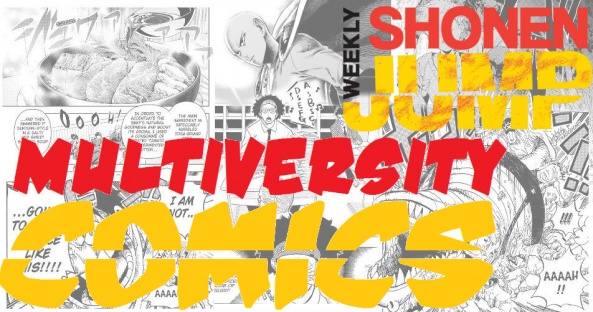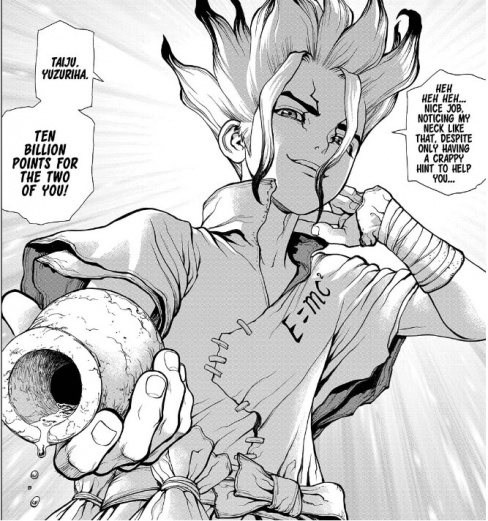
Welcome to This Week in Shonen Jump, in which a rotating duo of Multiversity staffers take a look at two stories contained in each installment of Viz Media’s Weekly Shonen Jump. For the uninitiated, Weekly Shonen Jump is an anthology that delivers more than 200 pages of manga of all varieties. We hope that you’ll join us in exploring the world of Weekly Shonen Jump each week. If you are unfamiliar, you can read sample chapters and subscribe at Viz.com.

This week, Matt and Rowan check in with “Cross Account” and “Dr. Stone.” If you have any thoughts on these titles, or “Shudan,” “One Piece,” “Robot X Laserbeam,” “The Promised Neverland,” “Black Clover,” “We Never Learn,” or “Food Wars,” let us know in the comments!

Cross Account Chapter 1
Written and Illustrated by Tsunehiro Date
Reviewed by Matt Lune
It took a second read through of this, the debut chapter and new Jump Start series to get what it was trying to do. Almost right off the bat, it shows the main character walking into a gratuitously framed, double page spread of the girl’s locker room in his high school, complete with butt shots and barely concealed bodies. Later on, there’s also a shower scene with a central female character, as well as a couple of other unfortunately exploitative moments throughout that are pretty off-putting, even if they are somewhat expected in high-school shonen manga at this point. There is a promising story underneath this, however, the objectification of the female cast isn’t the only problem here.
Daichi Tamanashi, our central protagonist, identifies himself early on as a normal high school student, yet pretty soon it’s established that he’s secretly an Otaku (major anime/manga fan) that constantly hides his true self behind a seemingly ‘harmless’ exterior. He’s done such a good job at trying to be bland and unthreatening that when he walks into the girl’s locker room in the scene mentioned above, all of the girls shrug it off and continue to change, calling him ‘Mr. Harmless,’ which Tamanashi sees as entirely emasculating. The plot of “Cross Account” is framed around the concept that Tamanashi is surrounded by ‘Normies,’ and as such has to hide his true self, but by aiming squarely for the center of the pack he’s completely alienated himself from everyone, even fellow Otakus. The only place he can truly be himself is online where on a Twitter-like site (it’s called Donkey Ears but it’s exactly the same as Twitter) he can confess to his wildest Otaku dreams and everyone loves him for it. He even makes a like-minded friend called ‘Poop Head,’ who claims to be in exactly the same situation as Tamanashi, however, they are more than they seem.
Here’s the problem with “Cross Account.” Tamanashi already has the evidence in front of him – thanks to Donkey Ears – that by being himself he can be more popular than he currently is, he just doesn’t have the confidence to go through with it. He actually states at one point that he’d rather be made fun of for being ‘Mr. Harmless’ than by being himself. In itself that’s perfectly understandable: many of us have been bullied in the past for loving the things we do, and many of us have even gone so far as to downplay those parts of our lives in order to more properly fit in. The trouble with “Cross Account” however, at least in this first chapter, is that Tamanashi, while intended to be relatable, comes across as the ultimate ‘Nice Guy:’ the guy that blames everyone else for his own insecurities, creating these imaginary hierarchies of people around him, bemoaning the fact that no girl ever sees him as a real man when the truth is, thanks to this fake shield he’s put around himself, there’s nothing real about him.
Case in point: his closest friend is Mao Takamine, a girl that he classes as the ‘source of all evils’ because she likes to wind him up in front of others and has done so all of his life. She came up with the name ‘Mr. Harmless,’ but when he blows up at her for it and storms off, she’s literally oblivious as to why it would upset him. It hasn’t occurred to him that it’s a sign of affection, and perhaps the reason people call him that is because they can see quite clearly that he’s trying too hard. There’s also an element of male fantasy wish fulfillment in “Cross Account” specifically concerning Takamine. The turning point for Tamanashi comes when he witnesses the three Otakus from his class sneak into the girl’s shower to catch his friend Takamine in the nude. They snap pictures of her, threatening to post them online if she doesn’t do what they want. The point of this scene is to prove that no matter what category Tamanashi places people in, jerks are jerks; these Otakus might be just like him, except they’re horrible humans that try to exploit someone in a terribly demeaning way. The art is an extremely gratuitous and objectifying depiction of Takamine in the shower, and the whole scene is played as a stereotypical Damsel in Distress trope that Tamanashi engages in. A scene that should be where one friend helps another turns into a moment where Tamanashi ‘finally becomes a man,’ at the expense of Takamine’s character. “I can’t leave a girl in trouble alone!” he says at one point – really?! She’s your friend, you jerk! You should be helping her because she’s being abused, not because it’s what a ‘man should do.’
Continued belowThere are some clever moments in the art, mostly concerning the depiction of the other people on the social media app. As they follow and comment on Tamanashi’s blog posts, they literally appear next to him as almost spectral beings with square profile pictures instead of heads. It’s a cute touch, especially when ‘Poop Head’ is interacting with Tamanashi, as it humanises the interactions in a way that seeing him stare at a screen wouldn’t do. Unfortunately, this can’t compensate for the overly sexualised art throughout the rest of the book.
Overall, it’s clear where “Cross Account” is going, at least in the short-term, and while it does take a second read-through to get there, it is possible to see what was being attempted here. The unlikeable characterisation of Tamanashi however, along with the gratuitous art and the attempts to justify some pretty sexist story beats (going so far as attempting to make them relatable,) all come together to make for an uncomfortable reading experience.
Final Verdict: 4.0 – Some ‘Nice Guy’ behaviour and downright exploitative art make this an unpleasant, frustrating read at times, despite an attempt to convey complex social norms.

Dr. Stone Chapter 15
Written by Riichiro Inagaki
Illustrated by Boichi
Reviewed by Rowan Grover
“Dr. Stone’s” tongue-in-cheek approach to a post-apocalyptic situation is so refreshing in the midst of a lot of gritty comics in the same vein. There’s a great balanced tone that makes this manga so approachable to almost anyone, and every chapter feels like a great entry point. I love the protagonist Riichiro Inagaki gives us in Senku. He’s a fresh breath of air for Shonen Manga, feeling scientific and decisive like Sherlock Holmes, yet you can’t shake the sinister air about him. Especially when Senku suggests his idea of warring with Tsukasa’s tribe, his character feels like a real grey area, giving some highly engaging reading.
Balancing this character is the voice of innocence, Taiju, who feels more like a traditional protagonist. Inagaki drives him purely by love – love for Yuzuriha, his pre-apocalypse date, and a kind of awe-love for Senku. I find his love for Senku to be the most interesting – Inagaki writes Taiju with a pretty solid moral compass, but it seems whenever Senku suggests an order, Taiju blindly follows. It makes for an intriguing relationship that Inagaki seems to be developing – I can definitely see doubt seeded in Taiju moreso than I could in earlier chapters, and it works well to drive the plot.
Boichi’s artwork here is super-clean, a style that completely elevates “Dr. Stone” above it’s counterparts. The linework is smooth, yet thick and heavy to create more substance and depth. It works great with Boichi’s inate sense of scale – camera angles are used professionally to achieve suitable drama or mystery for a scene. This works straight off the bat with the ¾ splash of Senku being revived. Boichi places the camera underneath him, having us look up (in awe) at his majestic figure, which also happens to be poised in front of a gleaming sun. Boichi adds that messianic element to Senku, which deepens his character without reliance on exposition – a touch that also makes him appear humble.
Boichi uses typical manga tropes well to convey storytelling, the most notable here being the contrast between cutesy and serious character work. Taiju’s character is a great example of this, as he embodies the extremes of these traits, particularly in this issue. Taiju’s reaction to Senku suggesting they find Tsukasa combines the exaggerated features, nosebleed/drip and steam erupting from ears into one panel, showing us that he works as a comedic character. However, one of the most touching scenes in the book comes from Taiju at the end, when he realises that he may not see Senku for some time. Boichi has his facial expression slowly change to react to this, and has him send of Senku in a one page splash proudly thrusting his fist into the air. We get the same kind of intense emotions as the last scene, yet it’s represented with genuine emotion that we elicit a very different response.
Dr. Stone is a refreshingly original manga that’s all about balance. The characters aren’t strictly good or evil. It’s a post-apocalyptic situation that still retains humour and light-heartedness. Inagaki and Boichi show that they’re clear professionals of the manga game, and every week I’m intrigued to see how the story unfolds.
Final Verdict: 9.2 – Dr. Stone is a lot of fun, and easily accessible. Even in its fifteenth chapter, I recommend you jump on the train and see what the fuss is all about.






